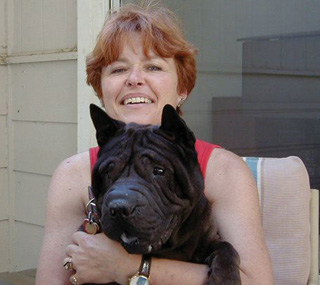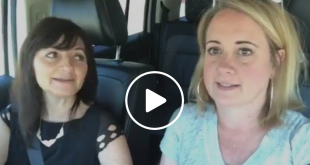 Cheryl Wicks is an everyday woman living in Grass Valley, CA. Ten years ago, Cheryl, a psychologist and professional coach, moved to the Sierra Nevada Foothills with her partner Curt Romander to retire. Looking for ways to get involved in her new community she began volunteering at the local animal shelter. Cheryl had always had a passion for animals and inspired by her experiences at the shelter and her beloved Shar-Pei named Sammie, she and Curt started Sammie’s Friends, a non-profit organization that provides medical care for the animals at the Nevada County Animal Shelter, making them adoptable and to support other disadvantaged animals in Nevada County without help that would otherwise be euthanized to end their suffering. This July, Sammie’s Friends took over the contract from the County to run the animal shelter. With the support of hundreds of volunteers they have provided care to, found homes for, and saved the lives of thousands of animals.
Cheryl Wicks is an everyday woman living in Grass Valley, CA. Ten years ago, Cheryl, a psychologist and professional coach, moved to the Sierra Nevada Foothills with her partner Curt Romander to retire. Looking for ways to get involved in her new community she began volunteering at the local animal shelter. Cheryl had always had a passion for animals and inspired by her experiences at the shelter and her beloved Shar-Pei named Sammie, she and Curt started Sammie’s Friends, a non-profit organization that provides medical care for the animals at the Nevada County Animal Shelter, making them adoptable and to support other disadvantaged animals in Nevada County without help that would otherwise be euthanized to end their suffering. This July, Sammie’s Friends took over the contract from the County to run the animal shelter. With the support of hundreds of volunteers they have provided care to, found homes for, and saved the lives of thousands of animals.
Where did your passion for animals come from?
In 1991, this dog named Sammie came into my life in an unexpected way. I took in this little, seven-week old Shar-Pei and later learned that a Shar-Pei was not the right dog for a first time dog owner, so I decided I better learn everything I could about this dog. When I took Sammie to the dog trainer he said he had trained over 7,000 dogs and Sammie was the most interesting dog he had ever met. It was no accident he popped into my life.
What was it about Sammie that inspired you to start Sammie’s Friends?
Sammie had a great life and I thought wouldn’t it be nice if every animal could have the same love and care.
Before starting Sammie’s Friends did you have any previous experience in non-profits?
No not at all. Curt and I moved to Grass Valley in 2000 from the Bay Area, and in 2001 we began volunteering at the Animal Shelter. When I got there, there were no volunteers, there was only one person to care for the animals, and the shelter was euthanizing 68% of the animals. I went there thinking I would walk the dogs once a week, but things looked pretty dismal and I thought what could one person do? All I had to offer was a little kindness, a cookie, a pat on the head and a walk. It was a minimal contribution, but more than anyone was doing. In August of that year, I asked the Ag Commissioner who ran the shelter, if I could start a volunteer program. Within a year we had 100 volunteers. More and more volunteers would tell their friends, and more animals began getting adopted. There are two reasons animals are killed, the first is there are more coming in than going out and the second is because they are sick or injured and at the time the County would spend $50 per animal. Many need more than an office visit, so they would just put them down. I would see a sick or injured animal and take them to the vet and pay for it out of our own pocket. Than Curt and four other volunteers began helping with the vet bills for the animals. Curt and I spent $30,000 of our own money, and decided it would be best to file for non-profit status so we could solicit funds and donations. Another woman started putting the animals on Petfinder.com and that helped our animals to be seen all over the world and increase their chances of finding a home.
What’s an average day like at the Shelter?
Everyday is hectic. We start in the morning by preparing the animals to be transported to the vet to be spayed and neutered. Inmates from Wayne Brown Correctional Facility help with cleaning the dog kennels. Because so many of our animals are sick or injured volunteers help administer medication and monitor the animals. Right now we have puppies that need bottle-feeding. By noon the kennels are clean and open for the public. We also have a feral cat colony that we take care of, and sometimes there is a barnyard animal we need to look after. By afternoon the adoptions start. It is quite a process to try to make sure each cat and dog is matched with the right person. Adoptions are over at 4pm and we begin getting the animals ready for nighttime. In between everything, we are doing grant writing, interviews, writing articles for the paper, hosting the weekly NCTV Pet Sake show, building maintenance, accounting and finance.
Have you seen an increase in animals being turned into the shelter due to the economy?
Most of the animals are stray animals; some are owner turn-ins, about 10% come from Animal Control, but the community brings many to us. In the last year or two, we’ve seen more people just pack up their bags and leave because they have lost their home, their job and can’t take care of their animals, so they just leave the animal. No domestic animal cat or dog can take care of itself.
What do you think the impact of starting this organization has had on you?
It makes me feel really good about myself. If you want to have high self-esteem – go help someone else. My training is in psychology, and I believe I’m going through what is called the Erickson stage of life, which is this period of stagnation or regeneration for people between the ages of 50-60. I’m done with my career and now I can do something that gives back. And in this case my passion is for animals.
What is your message to women around the world?
One person can make a difference. Decide on something that is important to you and go for it, whether you think you can or can’t. A lot of people looked at me as a moron, they called me a humaniac, but after they saw the progress, we took the euthanization rate from 68% down to 25%. The Animal Control staff were so grateful that they no longer had to kill animals. I told them that I believed we could find homes for the animals and we did for many. I loved Sammie so much because he and I were kind of alike – I have a mind of my own, I haven’t left my own path, and nothing discourages me.
5 Things You Can Do Today To Help Our Furry Friends Out!
- Volunteer – volunteers are always needed to help with hands-on care for the animals or with administrative duties and grant writing.
- Donate – all donations are tax deductible. You can also donate animal supplies and services.
- Advocate – encourage friends, family, and co-workers to adopt animals from shelters.
- Spay and neuter your pet. Not only is this good for your pet and you, it is good for the community. Communities spend millions of dollars to control unwanted animals, spaying/neutering decreases the homeless animal population. The Human Society’s 17th annual Spay Day takes place on Tuesday, Feb. 22, 2011, with events and activities in honor of Spay Day taking place throughout February.
- Put your passion into action. Learn more about Sammie’s Friends at www.sammiesfriends.org
 See Jane Do Everyday Women Doing Extraordinary Things
See Jane Do Everyday Women Doing Extraordinary Things





